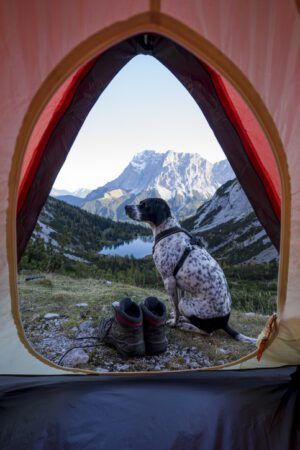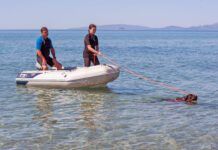
Camping with a dog, with or without an extended family, can make your experience extra fun or stressful. Here’s how to prepare for overnight adventures with your dog in the great outdoors.
Start with research
Search online for “dog friendly campgrounds” and you’ll find family installations, state and national parks, and RV parks in addition to the wilderness and your own neighborhood. Study a map or guide to your destination’s layout and amenities (including fenced dog parks or play areas), and. Campgrounds that allow dogs often have regulations and leash requirements – and may have restrictions on certain breeds. For a relaxing experience, make reservations early and organize your route to accommodate frequent rest stops.
It’s a great idea to locate the nearest emergency veterinary clinic to your destination, and keep its contact information handy. Snake bites, porcupine encounters, and heatstroke are just some of the potential hazards of camping that might necessitate a rapid trip to a vet; it helps to be ready.
Last but not least, check the weather forecast, so you’re prepared for rain showers, freezing or extreme heat, and other impactful weather conditions.
Get your dog ready
Schedule a veterinary checkup and discuss your plans with your vet to be sure the destination and planned activities are appropriate for your dog. Dogs can get lost on camping trips, so a microchip (registered with your current information), ID tag with your cell phone number, and current photo are recommended. Bring a correctly sized harness, spare leash, and other up-to-date equipment. If your dog needs a training refresher, practice loose-leash walking, recalls, and other basics before you leave. Aggressive dogs are not permitted at pet-friendly campgrounds, so consider leaving your dog home if travel, other dogs, new people, and unfamiliar surroundings create stress and reactive behavior.
Pack for your dog
Start a checklist so you’ll have the essentials, including food, water, and treats; prescription medications, if any; bedding; extra towels; pickup bags; and other equipment like a grooming brush, doggy daypack, rain jacket, paw protection, first-aid kit, outdoor dog toys, and a stake or tether. Bring an extra copy of your dog’s health records. Keep these items in a separate pack or bag.
Be ready to provide shade and shelter from hot summer sun with a canopy, a designated area in your tent, or portable crate.
Practice before you go
To prepare yourself and your dog for the trip, add extra walks, longer walks, and loose-leash walking to your daily regimen. If your dog doesn’t already spend time outdoors, start hanging out in the yard or nearby parks. If your dog doesn’t interact much with other dogs, set up play dates or visits to dog parks to help her feel comfortable around fellow canine campers. If you’re going to spend the night in your car or RV, make the back seat or dog sleeping area comfortable with familiar blankets, pillows, favorite toys, and a spill-proof water bowl.
If you’re camping in a tent, set it up in your back yard, keep your dog secure on a leash, prepare your own and your dog’s dinner just as you will on your trip. You might also invite friends to join you and spend the night with your dog in the tent or car or RV, making the experience as realistic as possible. This way you can address potential behavior challenges, or, at the least, help your dog acclimate to sleeping outdoors before you’re dealing with an aroused, wide-awake dog while surrounded by other sleeping campers.
With careful planning, you and your dog can enjoy a safe, fun, rewarding vacation and create a lifetime of camping memories.





